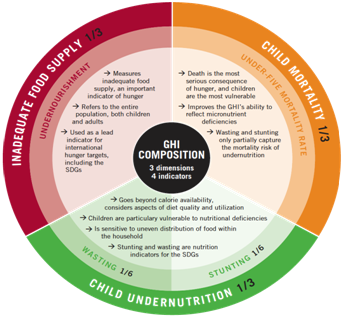

India has ranked 102 among 117 countries in Global Hunger Index 2019.
Context
India has ranked 102 among 117 countries in Global Hunger Index 2019.
About
- The Global Hunger Index (GHI) is a tool designed to comprehensively measure and track hunger at global, regional, and national levels.
- The International Food Policy Research Institute (IFPRI) calculates GHI scores each year to assess progress, or the lack thereof, in combating hunger.
- The GHI is designed to raise awareness and understanding of the struggle against hunger, provide a way to compare levels of hunger between countries and regions, and call attention to those areas of the world where hunger levels are highest and where the need for additional efforts to eliminate hunger is greatest.
How are the GHI scores calculated?
- GHI scores are calculated using a three-step process that draws on available data from various sources to capture the multidimensional nature of hunger.
- First step: For each country, values are determined for four indicators:
- Undernourishment: the share of the population that is undernourished (that is, whose caloric intake is insufficient).
- Child Wasting: the share of children under the age of five who are wasted (that is, who have low weight for their height, reflecting acute undernutrition).
- Child Stunting: the share of children under the age of five who are stunted (that is, who have low height for their age, reflecting chronic undernutrition).
- Child Mortality: the mortality rate of children under the age of five (in part, a reflection of the fatal mix of inadequate nutrition and unhealthy environments).

- Second step: Each of the four component indicators is given a standardized score on a 100-point scale based on the highest observed level for the indicator on a global scale in recent decades.
- Third step: standardized scores are aggregated to calculate the GHI score for each country, with each of the three dimensions (inadequate food supply; child mortality; and child undernutrition, which is composed equally of child stunting and child wasting) given equal weight.
- This three-step process results in GHI scores on a 100-point GHI Severity Scale, where 0 is the best score (no hunger) and 100 is the worst. In practice, neither of these extremes is reached.
- A value of 0 would mean that a country had no undernourished people in the population, no children younger than five who were wasted or stunted, and no children who died before their fifth birthday.
- A value of 100 would signify that a country’s undernourishment, child wasting, child stunting, and child mortality levels were each at approximately the highest levels observed worldwide in recent decades.
- The GHI Severity Scale shows the severity of hunger - from low to extremely alarming - associated with the range of possible GHI scores.

|
About IFPRI:
|
GHI 2019 findings:
- India has slipped to 102 on the Global Hunger Index, way behind its South Asian neighbours: Pakistan (94), Bangladesh (88), Nepal (73), Sri Lanka (66) and China (25).
- With a score of 30.3, India suffers from a level of hunger that is serious.
- While India was 103rd in 2018 on the GHI, it was out of 119 countries surveyed, compared to a total of 117 countries this year. So, the country moving up to 102 cannot really be seen as an improvement.
- India’s child wasting rate is extremely high at 20.8 percent—the highest wasting rate of any country in this report for which data or estimates were available. Its child stunting rate, 37.9 percent, is also categorized as very high in terms of its public health significance. In India, just 9.6 percent of all children between 6 and 23 months of age are fed a minimum acceptable diet. As of 2015–2016, 90 percent of Indian households used an improved drinking water source while 39 percent of households had no sanitation facilities (IIPS and ICF 2017).
- At the regional level, South Asia and Africa South of the Sahara have the highest 2019 GHI scores in the world, at 29.3 and 28.4, respectively. These scores indicate serious levels of hunger according to the GHI Severity Scale.
- In contrast, the 2019 GHI scores of Eastern Europe and the Commonwealth of Independent States, Latin America and the Caribbean, East and Southeast Asia, and the Near East and North Africa range from 6.6 to 13.3, indicating low or moderate hunger levels.


